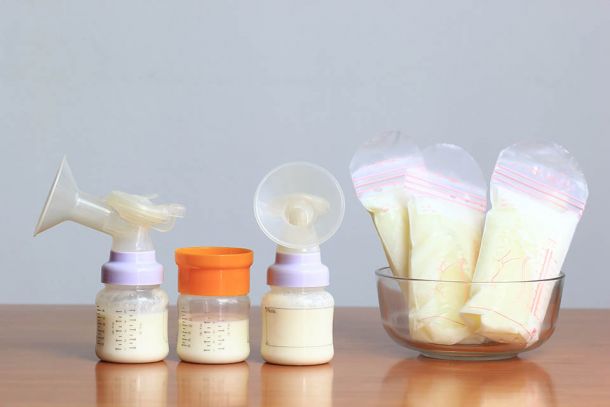Is one really better than the other?

You may be wondering why formula seems to have such a bad reputation when, if you were born during the 60’s or 70’s, there was a good chance you were bottle fed and there was no maternal anxiety over the decision. Back then, babies were also placed to sleep on their stomachs, a practice that is strongly advised against today due to the high risk of babies dying from SIDs. Medical knowledge has advanced greatly over the decades, as has our understanding of the unique properties of breast milk. And while many babies have successfully been nourished with formula, there are good reasons why breast milk is considered the best choice for babies.
Read more for a breakdown of the differences between breast milk and commercial formula.
Breast milk
Health Benefits for baby:
Designed by the human body to feed human babies, its composition changes to meet the needs of your baby or toddler.
Valuable antibodies protect babies against viral and bacterial infections such as:
- Ear infections
- Respiratory tract infections
- Urinary tract infections
- Bacterial meningitis
- Necrotizing Enterocollitis
The longer you breastfeed, the more protection your baby has.
Decreases the risk of Sudden Infant Death Syndrome (SIDS).
Improves baby’s brain development.
Easier to digest, decreasing baby’s risk of:
- Diarrhea
- Stomach Infection
- Inflammation of the stomach
Has an analgesic effect, meaning it comforts baby when he or she experiences pain.
Decreases your baby’s risk of developing health issues later in life such as:
- Obesity
- Crohn’s Disease
- Ulcerative colitis
- Celiac Disease
- Type I & II Diabetes
- High blood pressure
- Heart Disease
- High cholesterol
- Cancers such as acute lymphoblastic leukemia and neuroblastoma
Health benefits for mom:
Breast milk is always available, always the right temperature and always free. Breast milk requires no preparation.
Decreases your risk of developing:
- Breast cancer
- Ovarian cancer
- Cardiovascular Disease
- Type II Diabetes
- Metabolic syndrome
- Postpartum Depression
- Hypertension
- Osteoporosis
Alternative care-givers can feed your baby - if you express milk before hand.
Formula
Created in a lab, and in most cases, is commercially altered cow’s milk. Different brands and different types of formula can lead to confusion, mistakes in preparation and contamination, putting your baby’s health at risk.
Formula does not contain the same antibodies found in breast milk. There are substances added to formula to help protect babies from illness but these are not as easily absorbed by baby as breast milk and do not offer the same kind of protection. Higher concentrations of vitamins and minerals in formula make it more difficult to digest and more likely that your baby will suffer:
- Gas
- Constipation
- Upset stomach
Formula fed babies have a higher risk of SIDS.
Formula is expensive, the average cost is around $1,000 - $1,800 a year ($87 - $150 per month)
A 2013 World Health Organization report found formula fed babies scored lower on IQ tests than those who were breastfed.
Formula must be prepared following certain guidelines to ensure it is sterile and your baby doesn’t get sick. Bottles must always be thoroughly cleaned and sanitized.
Alternative care-givers can feed your baby - as long as they follow the proper safety guidelines for preparation.
For more information on the differences between breast milk and formula, read Dr Jack Newman's info sheet or visit our Ask the Expert section.
References
- Best Start Resource Centre. (2013). Breastfeeding Matters: An important guide to breastfeeding for women and their families.
- Clarke, S. (2008). Supporting the immune system through the weaning period. Journal Of Family Health Care, 18(1), [32-3].
- Health Canada, (2012). Nutrition for Healthy Term Infants: Recommendations from Birth to Six Months.
- Horta, B.L. & Victora, C.G. (2013). Evidence on the long-term effects of breastfeeding: Systemic Reviews and Meta-Analyses. World Health Organization.
- Ip, S., Chung, M., Raman, G., Trikalinos, T. A., & Lau, J. (2009). A summary of the agency for Healthcare Research and Quality’s Evidence Report on breastfeeding in developed countries. Breastfeeding Medicine, 18, 15-16.
- Kramer, M. S., Aboud, F., Mironova, E., Vanilovich, I., Platt, R. W., Matush, … Shapiro, S. (2008). Breastfeeding and child development: New evidence from a large randomized trial. Archives of General Psychiatry, 65(5), 578-584.
- Le Huërou-Luron, I., Blat, S., and Boudry, G. (2010). Breast- v. formula-feeding: impacts on the digestive tract and immediate and long-term health effects. Nutrition Research Reviews, 23, pp 23-36. doi:10.1017/S0954422410000065.
- Quigley, M. A., Kelly, Y. J., & Sacker, A. (2007). Breastfeeding and hospitalization for diarrheal and respiratory infection in the United Kingdom millennium cohort study. Pediatrics, 119(4), 207-215.
- Stuebe, A. (2009). The Risks of Not Breastfeeding for Mothers and Infants. Reviews in Obstetrics and Gynecology. 2(4)
- Shah, P. S., Aliwalas, L. L., & Shah, V. S. (2009). Breastfeeding or breast milk for procedural pain in neonates. Cochrane Database of Systematic Reviews, (3).
- World Health Organization. (2013). Long-term effects of breastfeeding: A Systematic Review.
